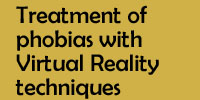A relatively new method to treat phobias is by means of virtual reality techniques. A number of research studies have demonstrated the positive effects of VR in the treatment of several types of phobia, such as fear of heights, fear of spiders, fear of flying and claustrophobia, as well as agoraphobia. New clinics have been established, specialized in virtual reality techniques to treat various phobias.
A car driving simulator is similar to a Virtual reality system, except for the helmet mounted displays (HMD’s). In both types of system, a computer generate world is presented to the client and the client can interact with this world. In the case of a driving simulator, you drive through the computer generated world as if you are seated in a real car and you interact with other traffic participants and the road infrastructure in a very realistic but also safe way.
For driving, the HMD as used in VR is not very well suited, because of the risk of cybersickness that comes with the use of HMD’s. This is aggravated because of two independent types of motions in driving a car:
- the vehicle moves through the world, controlled by the steering wheel and pedals of the driver.
- the client looks around in the environment by turning the head (head tracking)
These two types of motions in combination give a high risk of cybersickness in a VR system. The brain is not very well able to distinguish these movements. This is the most important reason that a driving simulator is a much better solution for the treatment of driving phobia or fear of driving: in a driving simulator the risk of ‘simulator sickness’ is a lot smaller, especially if the simulations are designed to keep lateral and longitudinal accelerations to a minimum.

